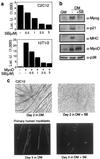p38 and extracellular signal-regulated kinases regulate the myogenic program at multiple steps
- PMID: 10805738
- PMCID: PMC85749
- DOI: 10.1128/MCB.20.11.3951-3964.2000
p38 and extracellular signal-regulated kinases regulate the myogenic program at multiple steps
Abstract
The extracellular signals which regulate the myogenic program are transduced to the nucleus by mitogen-activated protein kinases (MAPKs). We have investigated the role of two MAPKs, p38 and extracellular signal-regulated kinase (ERK), whose activities undergo significant changes during muscle differentiation. p38 is rapidly activated in myocytes induced to differentiate. This activation differs from those triggered by stress and cytokines, because it is not linked to Jun-N-terminal kinase stimulation and is maintained during the whole process of myotube formation. Moreover, p38 activation is independent of a parallel promyogenic pathway stimulated by insulin-like growth factor 1. Inhibition of p38 prevents the differentiation program in myogenic cell lines and human primary myocytes. Conversely, deliberate activation of endogenous p38 stimulates muscle differentiation even in the presence of antimyogenic cues. Much evidence indicates that p38 is an activator of MyoD: (i) p38 kinase activity is required for the expression of MyoD-responsive genes, (ii) enforced induction of p38 stimulates the transcriptional activity of a Gal4-MyoD fusion protein and allows efficient activation of chromatin-integrated reporters by MyoD, and (iii) MyoD-dependent myogenic conversion is reduced in mouse embryonic fibroblasts derived from p38alpha(-/-) embryos. Activation of p38 also enhances the transcriptional activities of myocyte enhancer binding factor 2A (MEF2A) and MEF2C by direct phosphorylation. With MEF2C, selective phosphorylation of one residue (Thr293) is a tissue-specific activating signal in differentiating myocytes. Finally, ERK shows a biphasic activation profile, with peaks of activity in undifferentiated myoblasts and postmitotic myotubes. Importantly, activation of ERK is inhibitory toward myogenic transcription in myoblasts but contributes to the activation of myogenic transcription and regulates postmitotic responses (i.e., hypertrophic growth) in myotubes.
Figures








Similar articles
-
p38 mitogen-activated protein kinase pathway promotes skeletal muscle differentiation. Participation of the Mef2c transcription factor.J Biol Chem. 1999 Feb 19;274(8):5193-200. doi: 10.1074/jbc.274.8.5193. J Biol Chem. 1999. PMID: 9988769
-
Permissive roles of phosphatidyl inositol 3-kinase and Akt in skeletal myocyte maturation.Mol Biol Cell. 2004 Feb;15(2):497-505. doi: 10.1091/mbc.e03-05-0351. Epub 2003 Oct 31. Mol Biol Cell. 2004. PMID: 14595115 Free PMC article.
-
Molecular mechanisms of myogenic coactivation by p300: direct interaction with the activation domain of MyoD and with the MADS box of MEF2C.Mol Cell Biol. 1997 Feb;17(2):1010-26. doi: 10.1128/MCB.17.2.1010. Mol Cell Biol. 1997. PMID: 9001254 Free PMC article.
-
Regulation of MEF2 by p38 MAPK and its implication in cardiomyocyte biology.Trends Cardiovasc Med. 2000 Jan;10(1):19-22. doi: 10.1016/s1050-1738(00)00039-6. Trends Cardiovasc Med. 2000. PMID: 11150724 Review.
-
Regulating a master regulator: establishing tissue-specific gene expression in skeletal muscle.Epigenetics. 2010 Nov-Dec;5(8):691-5. doi: 10.4161/epi.5.8.13045. Epub 2010 Nov 1. Epigenetics. 2010. PMID: 20716948 Free PMC article. Review.
Cited by
-
Inhibition of Notch3 signalling induces rhabdomyosarcoma cell differentiation promoting p38 phosphorylation and p21(Cip1) expression and hampers tumour cell growth in vitro and in vivo.Cell Death Differ. 2012 May;19(5):871-81. doi: 10.1038/cdd.2011.171. Epub 2011 Nov 25. Cell Death Differ. 2012. PMID: 22117196 Free PMC article.
-
Role of Actin-Binding Proteins in Skeletal Myogenesis.Cells. 2023 Oct 25;12(21):2523. doi: 10.3390/cells12212523. Cells. 2023. PMID: 37947600 Free PMC article. Review.
-
TRAF6 promotes myogenic differentiation via the TAK1/p38 mitogen-activated protein kinase and Akt pathways.PLoS One. 2012;7(4):e34081. doi: 10.1371/journal.pone.0034081. Epub 2012 Apr 4. PLoS One. 2012. PMID: 22496778 Free PMC article.
-
A role for Regulator of G protein Signaling-12 (RGS12) in the balance between myoblast proliferation and differentiation.PLoS One. 2019 Aug 13;14(8):e0216167. doi: 10.1371/journal.pone.0216167. eCollection 2019. PLoS One. 2019. PMID: 31408461 Free PMC article.
-
Myocyte enhancer factor 2 acetylation by p300 enhances its DNA binding activity, transcriptional activity, and myogenic differentiation.Mol Cell Biol. 2005 May;25(9):3575-82. doi: 10.1128/MCB.25.9.3575-3582.2005. Mol Cell Biol. 2005. PMID: 15831463 Free PMC article.
References
-
- Alemà S, Tatò F. Oncogenes and muscle differentiation: multiple mechanism of interference. Semin Cancer Biol. 1994;5:147–156. - PubMed
-
- Anderson J E. Murray L. Barr Award lecture. Studies of the dynamics of skeletal muscle regeneration: the mouse came back! Biochem Cell Biol. 1998;76:13–26. - PubMed
-
- Arnold H H, Winter B. Muscle differentiation: more complexity to the network of myogenic regulators. Curr Opin Genet Dev. 1998;8:539–544. - PubMed
-
- Beier F, Taylor A C, La Valle P. The Raf-1/MEK/ERK pathway regulates the expression of the p21 cip1/waf1 gene in chondrocytes. J Biol Chem. 1999;274:30273–30279. - PubMed
Publication types
MeSH terms
Substances
Grants and funding
LinkOut - more resources
Full Text Sources
Other Literature Sources
Molecular Biology Databases
Research Materials
Miscellaneous
